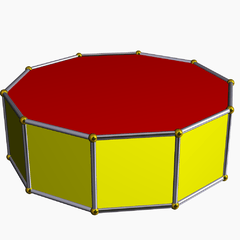Dip (Catalan myth)
In Catalan myth, Dip (Catalan pronunciation: [ˈdip]) is an evil, black, hairy dog, an emissary of the Devil, who sucks people's blood. Like other figures associated with demons in Catalan myth, he is lame in one leg. Dip is pictured on the escutcheon of Pratdip.
See also
Sources
El gran libro de los vampiros by Angel Gordon, Morales y Torres editores.Spanish
External links

Decagonal prism
In geometry, the decagonal prism is the eighth in the infinite set of prisms, formed by ten square side faces and two regular decagon caps. With twelve faces, it is one of many nonregular dodecahedra. The decagonal prism has 12 faces, 30 edges, and 20 vertices. If faces are all regular, it is a semiregular or prismatic uniform polyhedron.
Uses
The decagonal prism exists as cells in two four-dimensional uniform 4-polytopes:
Related polyhedra
External links

Dip (exercise)
The dip is an exercise used in strength training. Narrow, shoulder-width dips primarily train the triceps, with major synergists being the anterior deltoid, the pectoralis muscles (sternal, clavicular, and minor), and the rhomboid muscles of the back (in that order). Wide arm training places additional emphasis on the pectoral muscles, similar in respect to the way a wide grip bench press would focus more on the pectorals and less on the triceps.
Classic meaning
In past decades, the term floor dip was used in place of what is now called a press-up or push-up.
Modern meaning
To perform a dip, the exerciser hangs from a dip bar or from a set of rings with their arms straight down and shoulders over their hands, then lowers their body until their arms are bent to a 90 degree angle at the elbows, and then lifts their body up, returning to the starting position. Short people are able to cope better with a narrower grip, but not with a wider one.
Due to natural flexibility in the shoulder joints, it is important to try to "lock" them as much as possible during this exercise. Otherwise, the supporting rotator cuffs may become strained.

Trampoline
A trampoline is a device consisting of a piece of taut, strong fabric stretched over a steel frame using many coiled springs. People bounce on trampolines for recreational and competitive purposes.
The fabric that users bounce on (commonly known as the 'bounce mat' or 'trampoline bed') is not elastic in itself; the elasticity is provided by the springs that connect it to the frame, which store potential energy.
History
Early trampoline-like devices
A game similar to trampolining was developed by the Inuit, who would toss each other into the air on a walrus skin (see Nalukataq). There is also some evidence of people in Europe having been tossed into the air by a number of people holding a blanket; Mak in the Wakefield Second Shepherds' Play and Sancho Panza in Don Quixote are both subjected to blanketing – however, these are clearly non-voluntary, non-recreational instances of quasi-judicial, mob-administered punishment. The trampoline-like life nets once used by firemen to catch people jumping out of burning buildings were invented in 1887.

Trampoline (song)
"Trampoline" is a song by English rapper Tinie Tempah, and the lead single from his second studio album Demonstration (2013). The song features an additional rap verse from American rapper 2 Chainz, and was released on 4 August 2013. It debuted at number three in UK Singles Chart on 11 August 2013.
Background and release
A series of short trailers for "Trampoline", getting gradually longer in length, teased different sections of the instrumental and music video. Each teaser features the symbolic red stripe, which is included in the official cover artwork for the single. The first teaser was five seconds long and simply a synth and sub drop, a Southern US style of production. It uses a brand new Tinie Tempah logo, and Tinie's website "shook" as a reference to the "shake, shake, shake" in the song. The second is seventeen seconds long and shows a hanging microphone, accompanied by slightly more of the track. The third shows a hooded Tinie, accompanied by a different section of the track. At the end Tinie says "yeah". The fourth and final trailer was released a day prior to the premiere of the track, and includes part of the chorus. It shows Tinie walking up to the camera and grinning.

Trampoline (Joe Henry album)
Trampoline is the sixth studio album by Joe Henry, released in 1996. It featured a musical collaboration between Henry and guitarist Page Hamilton of alternative metal band Helmet and included a cover version of "Let Me Have It All" from Sly and the Family Stone's 1973 Fresh album.
Background
Interviewed on the Sessions at West 54th TV show in 1998, Henry said when he began making Trampoline, he was determined to learn a new way to work. "Usually because I didn't have enough money and I didn't know how to work any other way. Just live in the studio. Get a band, circle the wagons, and then just kind of have at it. And it's more like making a documentary film, you get what you get, problems and all. More like live theater. And I wanted to think more like a filmmaker, I wanted to be able to manipulate things more. And work on it in bits and pieces and I started by setting up a little studio at home and exactly that.
"I came up with a drum loop first, and thought, 'Jeez, I've never written, here's a rhythm, I've never operated under this umbrella. Let's do this one.' And then make myself write to that. And, I just learned to work backwards. I think it's good to be disoriented to a certain degree."
Podcasts:

